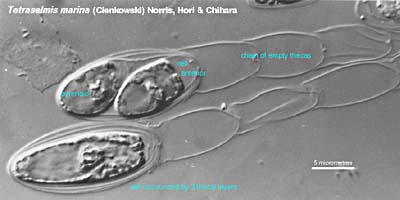
The Pleurastrophyceae comprises less than a dozen genera and a handful of species. The group is not as well-defined as the other groups of green algae, because it was first recognized as a group only in 1984. What makes the group distinctive is the way in which the cells divide during mitosis.
Pleurastrophyceans have a metacentric spindle, a trait rare among green algae and not known from other protist groups (Mattox & Stewart 1984). Unlike the usual pattern of cell division, the basal bodies or centrioles (depending on which is present) do not migrate to the poles of the cell before the spindle forms. It is believed that in most other groups, the basal bodies act as a center from which the spindle formation and movement is coordinated, but this does not seem to be the case here.
A further oddity of pleurastophyte cell division is that the cleavage furrow that divides the cytoplasm forms from one side only, rather than pinching from both sides.

Tetraselmis : A putatively "primitive" pleurastrophycean. This is the only genus assigned to this group to retain the plesiomorphy of flagellar scales; it may actually be a micromonad.
Like most members of the closely related Chlorophyceae, all Pleurastrophyceae are found in freshwater and soil, not in marine habitats. But, like the Ulvophyceae, they have an "11 o'clock-5 o'clock" flagellar arrangement. Unlike either group, all known reproduction is asexual.
Strictly speaking, the Pleurastrophyceae have no fossil record. However, the genera Trebouxia, Pseudotrebouxia, and Myrmecia are the most common green algae found associated with fungi to form lichens, which are known from fossils as early as the Devonian.
Try the Protist Image Data Base for information about Tetraselmis.

Image used on this page provided courtesy the PID, and should not be used without their permission.

